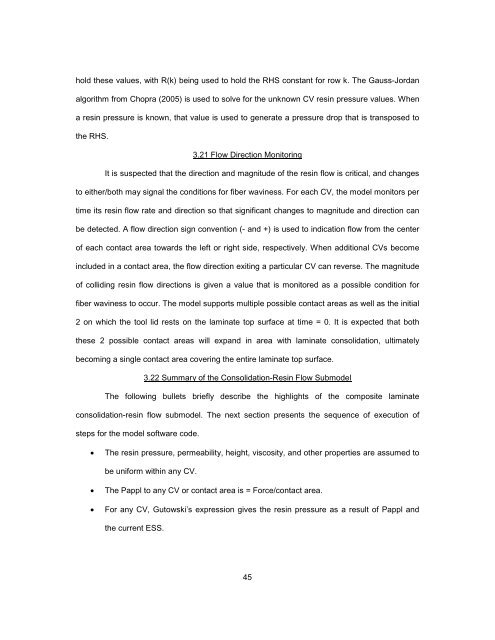TOOLED THICK COMPOSITES by ARVEN H. SAUNDERS III ...
TOOLED THICK COMPOSITES by ARVEN H. SAUNDERS III ...
TOOLED THICK COMPOSITES by ARVEN H. SAUNDERS III ...
Create successful ePaper yourself
Turn your PDF publications into a flip-book with our unique Google optimized e-Paper software.
hold these values, with R(k) being used to hold the RHS constant for row k. The Gauss-Jordan<br />
algorithm from Chopra (2005) is used to solve for the unknown CV resin pressure values. When<br />
a resin pressure is known, that value is used to generate a pressure drop that is transposed to<br />
the RHS.<br />
3.21 Flow Direction Monitoring<br />
It is suspected that the direction and magnitude of the resin flow is critical, and changes<br />
to either/both may signal the conditions for fiber waviness. For each CV, the model monitors per<br />
time its resin flow rate and direction so that significant changes to magnitude and direction can<br />
be detected. A flow direction sign convention (- and +) is used to indication flow from the center<br />
of each contact area towards the left or right side, respectively. When additional CVs become<br />
included in a contact area, the flow direction exiting a particular CV can reverse. The magnitude<br />
of colliding resin flow directions is given a value that is monitored as a possible condition for<br />
fiber waviness to occur. The model supports multiple possible contact areas as well as the initial<br />
2 on which the tool lid rests on the laminate top surface at time = 0. It is expected that both<br />
these 2 possible contact areas will expand in area with laminate consolidation, ultimately<br />
becoming a single contact area covering the entire laminate top surface.<br />
3.22 Summary of the Consolidation-Resin Flow Submodel<br />
The following bullets briefly describe the highlights of the composite laminate<br />
consolidation-resin flow submodel. The next section presents the sequence of execution of<br />
steps for the model software code.<br />
• The resin pressure, permeability, height, viscosity, and other properties are assumed to<br />
be uniform within any CV.<br />
• The Pappl to any CV or contact area is = Force/contact area.<br />
• For any CV, Gutowski’s expression gives the resin pressure as a result of Pappl and<br />
the current ESS.<br />
45
















